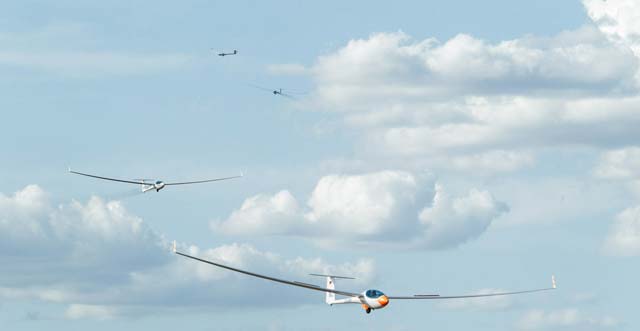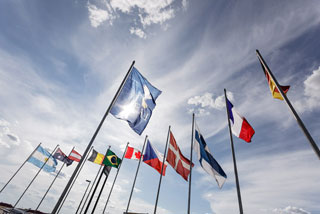 Tightly packed groups of gliders vied for speed and the power of thermals, though there was only one collision--with no injuries--at the World Glider Championships.
Tightly packed groups of gliders vied for speed and the power of thermals, though there was only one collision--with no injuries--at the World Glider Championships.
High in the sunlit silence, though hardly hov’ring there, sailplane pilots from around the world posted “tremendous” speeds at the Thirty-second World Gliding Championships in Uvalde, Texas—the first time the biennial event has taken place on U.S. soil in decades.
The event, long dominated by European pilots, drew 98 entries from 24 nations, a crowded field that collectively logged nearly 500,000 miles flown over two weeks, matching the (average) distance from the Earth to the moon—and back. There was one midair collision during the two-week event, though both pilots escaped unharmed (one able to land, and the second parachuting to safety).
The World Gliding Championships Director Ken Sorenson said the French pilot and Austrian pilot who collided Aug. 17 were believed to be part of a group of five or six sailplanes sharing space in a thermal. The French pilot was able to land his damaged glider (escorted by two fellow competitors who broke off from the race to render assistance), while the Austrian pilot bailed out and was picked up by a helicopter and soon returned to the airport.
While gliders can be equipped with electronic collision warning systems, “any of the collision avoidance systems become of limited value when you have gliders that are circling in close proximity with each other,” Sorenson said. “They just got too close.”
Sorenson said anti-collision electronics are growing more common, though organizers strive to design tasks, as the daily flights are known, that will keep traffic as separated as possible.
“We do our best to set the courses to minimize conflict,” Sorenson said. “Sometimes, it’s just not possible.”
 Top sailplane pilots from around the world converged on Uvalde, Texas, for the Thirty-second World Glider Championships.
Top sailplane pilots from around the world converged on Uvalde, Texas, for the Thirty-second World Glider Championships.
The safe return of both pilots was celebrated, along with many other successes. Over relatively flat terrain that is generally less conducive to speed than mountainous areas, top pilots posted average speeds approaching, and in one case exceeding 100 mph over race courses that stretched 300 miles or more.
U.S. pilot Dick Butler, flew the custom-built Concordia to a seventh-place finish in the final standings in the open class—a very respectable finish, Sorenson said, noting the decade-long effort to design and build Concordia finished weeks before the competition.
Butler was also up against a record-setting field, with more points collectively earned than ever before, Sorenson said—official confirmation of that is pending. Laurent Aboulin of France won the open class, with 12,084 points. Zbigniew Nieradka captured the 18-meter title with 12,170 points, and Sebastian Kawa, also of Poland, took the 15-meter title with 11,062 points.
Sorenson pronounced the event a success, crediting pilots and more than 100 volunteers from around the country who converged on Uvalde to run soaring’s equivalent of the Olympics. The next championship will be in Poland in 2014.
“It was a huge deal” to have the event on U.S. soil, Sorenson said.
The championship is typically held in Europe because of the high cost of shipping gliders and teams across oceans, though Uvalde proved a popular choice, Sorenson said.
“We had good weather; we had lots of flying,” Sorenson said, noting many pilots logged 100 hours or more. “We had lots of smiling faces on pilots as they left. Smiling, but tired.”



